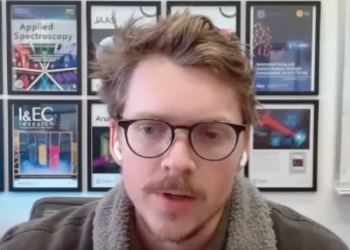
Leading by Example: A Retrospective on the Career of Ulrich J. Krull
A celebration of the 36-year career of Ulrich J. Krull, on the occasion of his retirement earlier this year.
We’d like to take a moment to celebrate the 36-year career of Ulrich J. Krull, on the occasion of his retirement earlier this year. Ulli is an outstanding example of a researcher, educator, and leader in the field of analytical chemistry who has also been an enthusiastic and tireless driver of academic partnerships with industry, government, and communities.
Ulli was born in 1956 in Berlin, Germany, and immigrated to Canada with his family in 1959. Raised in the greater Toronto area, Ulli met Carol—his high-school sweetheart, wife of 41 years and counting, and greatest supporter—at age 16. Ulli obtained his BSc, MSc, and PhD degrees from the University of Toronto between 1975 and 1983. In 1985, he joined the University of Toronto’s Mississauga campus (UTM) as an Assistant Professor. At this time, UTM was a campus of 3500 full-time and part-time students and had two main buildings for teaching and research.
The initial work in Ulli’s research group focussed on the development of artificial membranes for chemical sensing applications—specifically, how interfacial perturbations (such as changes in pH) from selective binding interactions could alter the structure of an underlying artificial lipid bilayer membrane. These alterations in membrane structure were transduced by environmentally sensitive fluorophores embedded within the membranes and detected spectroscopically (1,2). A subsequent transition from liquid-supported membranes to solid-supported membranes was Ulli’s first foray into fiber-optic chemical sensor development, which would continue for many years (3).
The first of many leadership roles at UTM came in 1994, when Ulli became the Associate Dean of Sciences. His first challenge—at the request of the Mayor of Mississauga, Hazel McCallion—was to devise a mechanism to build a “healthy city” by leveraging the expertise and advances at UTM for the benefit of the civic community. With the engagement of UTM students, faculty, and staff, Ulli formulated a plan that resulted in the formation of the UTM-City of Mississauga Healthy City Stewardship Centre. This centre fostered a city of people with physical, mental, and spiritual health through the provision of equal access to information and services, maintenance of a clean and sustainable environment, and the establishment of a supportive community culture and public services. This effort was ultimately recognized with the World Leadership Award in 2006, and the mayor enjoyed another 20 consecutive years in office before retiring. By this point, UTM had grown to approximately5000 full-time and part-time students and saw its first major infrastructure expansion with the opening of a third academic building in 1992.
Inspired by the initiation of the human genome project, the early 1990s saw Ulli’s research program pivot to the development of fluorimetric fiber optic DNA biosensors for the detection pathogenic bacteria and single nucleotide polymorphisms associated with human disease. His group quickly established their place among the leaders in this field, with seminal papers amassing over 500 citations to date, as per citation counts (08/2021) for individual papers from Google Scholar, and career citation counts from Web of Science (4,5). Further research saw innovations in interfacial chemistry, including refractive index matching between immobilized oligonucleotide films and underlying waveguides to bypass evanescent fields and obtain direct excitation and high-efficiency recovery of fluorescence (6), and fundamental studies and new methods for using high oligonucleotide probe densities to optimize binding selectivity (7). Much of this research was bookended by the McBryde Medal (1994) and Maxxam Award (2002), the two highest honors for analytical chemistry research in Canada. During this same period, Ulli was also named the AstraZeneca Chair in Biotechnology, won a Teaching Excellence Award at UTM, began his 20-year tenure as an editor for Analytica Chimca Acta, and won the University of Toronto’s premier tri-campus honor for excellence in research, teaching, and service.
The new millennium brought many new leadership challenges and opportunities for Ulli, including terms as Vice Principal of Research (2003–13), Vice Dean graduate (2006–08), Vice Principal of Special initiatives (2012–16), and, ultimately, Principal of UTM and Vice President of the University of Toronto (2017–20). Over these years, Ulli led the creation of the Master of Biotechnology Program (2001), the Centre for Applied Biosciences & Biotechnology (2003), the Western Greater Toronto Area Convergence Centre (2005; technology commercialization and university-industry-government networking), the Research Innovation Commercialization Centre (2009; a not-for-profit innovation hub and business incubator service), the Mississauga Academy of Medicine (2011), the Institute for Management and Innovation (2014; a professional school bridging business with health and science), the Continuum Robotics Laboratory (2019), and a new science building that is now under construction. The new science building is the largest capital project initiated to date across all three campuses of the University of Toronto.
Ulli’s vision and dedication has been rewarded with a thriving UTM campus that now boasts over 15,000 undergraduate students, 860 graduate students, 1200 permanent faculty and staff, and 9 academic and research buildings. It is no surprise that Ulli won the Paul W. Fox Award (2011) from the UTM Alumni Association for distinguished voluntary service and promotion of the university and was named one of the 50 most influential people in the 50-year history of UTM (2017). As a further tribute to his accomplishments in research, innovation and in citizenship, the Ulrich J. Krull Research Excellence Award was established in 2020 to recognize students who combine outstanding research with leadership in entrepreneurship or community engagement (8).
Even with his many leadership roles, Ulli maintained a vibrant research program. Research toward the design of surface chemistry to optimize nucleic acid binding selectivity continued with mixed films of polymers and oligonucleotides, strategies were explored for the use of tethered intercalating dyes for DNA biosensor development, and microfluidics (9,10) and luminescent nanomaterials were added as tools for the development of nucleic acid biosensors. The latter included some of the earliest explorations of the use of semiconductor quantum dots and lanthanide-based upconversion nanoparticles for the detection of nucleic acids by energy transfer, as well as fundamental investigation and optimization of nanoparticle interfacial chemistry. Some of this nanoparticle research has been cited over 500 times (11–14).
Over his career, Ulli published more than 270 research articles, accrued nearly 7300 citations, generated more than a dozen patents, was involved with multiple start-up biotechnology ventures, supervised 51 graduate theses, helped organize 45 conferences and symposia, held 17 editorial roles, gave more than 400 invited lectures, attracted or co-attracted $30M CAD in research and infrastructure funding, and was recognized by 28 awards and honors for excellence in research, teaching, and service. His research toward selective biosensor technologies, and his recognition of the importance of interfacial chemistry in this endeavor, will continue to resonate in the field for years to come.
The foregoing summary is a glimpse into the energy and achievements of Ulli Krull, scientist and leader, but we cannot begin to convey the personal impact he had on his communities. His ambition, inventiveness, and dedication has touched the lives of countless people across the city of Mississauga and the whole of Southern Ontario. His humility and kind and enthusiastic teaching and mentorship has inspired innumerable students and colleagues. He is respected from coast-to-coast in the scientific community in Canada and throughout the international analytical chemistry community. He also engaged and supported a myriad of people through more than 25 years as an instructor with the UTM Judo Club, activities with Scouts Canada, community and school outreach events, patronage of The Riverwood Conservancy, and membership in the Royal Astronomical Society of Canada.
Although Ulli’s colleagues and communities will miss him, they are all excited for this next and well-deserved chapter in his life. Four generations of Ulli’s loving family and many good friends are looking forward to spending more time with him.
Ulli, thank you for all that you have done to enrich our lives. We wish you all the best in retirement.
References
With apologies to all authors whose publications we did not have space to cite.
(1) U.J. Krull, J.D. Brennan, R.S. Brown, S. Hosein, B.D. Hougham, E.T. Vandenberg, Analyst, 115, 147–153 (1990).
(2) J.D. Brennan, R.S. Brown, C.P. McClintock, U.J. Krull. Anal. Chim. Acta, 237, 253–263 (1990).
(3) U.J. Krull, R.S. Brown, B.D. Hougham, I.H. Brock. Talanta, 37, 801–807 (1990).
(4) P.A.E. Piunno, U.J. Krull, R.H.E. Hudson, M.J. Damha, H. Cohen, Anal. Chim. Acta, 288, 205–214 (1994).
(5) P.A.E. Piunno, U.J. Krull, R.H.E. Hudson, M.J. Damha, H. Cohen. Anal Chem. 67, 2635–2643 (1995).
(6) U.J. Krull, P.A.E. Piunno, R.H.E. Hudson, A. Uddin, M. Damha, US Patent 6,503,711, Jan. 2003.
(7) J.H. Watterson, P.A.E. Piunno, C.C. Wust, U.J. Krull, Langmuir, 16, 4984–499 (2000).
(8) https://www.utm.utoronto.ca/support-utm/student-support/ulrich-j-krull-research-excellence-award
(9) D. Erickson, D. Li, U.J. Krull. Anal. Biochem. 317, 186–200 (2003).
(10) D. Erickson, X. Liu, R. Venditti, D. Li, U.J. Krull, Anal Chem. 77, 4000–4007 (2005).
(11) W.R. Algar, U.J. Krull, Anal. Chim. Acta, 581, 193–201 (2007).
(12) W.R. Algar, U.J. Krull, Langmuir, 22, 11346–11352 (2006).
Newsletter
Get essential updates on the latest spectroscopy technologies, regulatory standards, and best practices—subscribe today to Spectroscopy.




